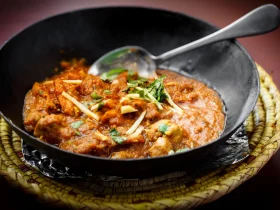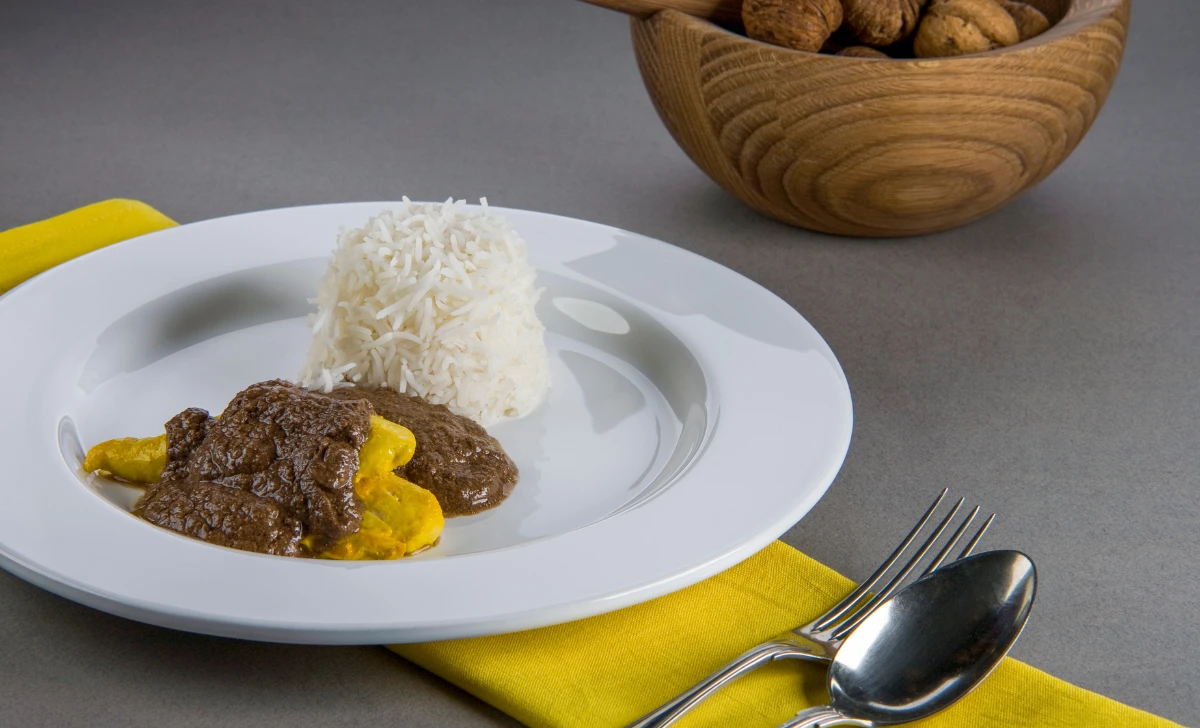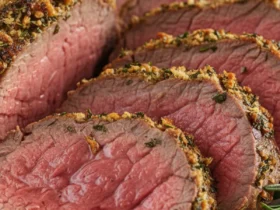Are you ready to embark on a culinary journey that promises to delight your taste buds and warm your soul? Look no further than the enticing world of Persian cuisine. Among the gems of this rich culinary tradition lies the Fesenjan, a dish that effortlessly weaves together the nutty goodness of walnuts with the tangy allure of pomegranates. Join me as we explore the captivating Fesenjan recipe and unlock the secrets to mastering this flavorful masterpiece.
[ez-toc]
History
Delve into the annals of culinary history, and you’ll uncover a tale as rich and layered as the flavors of Fesenjan itself. This iconic Persian dish, with its enchanting blend of walnuts and pomegranates, has woven itself into the fabric of Persian culture, embodying centuries of tradition and evolution.
Ancient Roots and Royal Delights
The roots of Fesenjan stretch deep into the annals of ancient Persia, where the art of cooking was considered a form of artistic expression. Persian cuisine has always been a testament to the land’s agricultural bounty, and Fesenjan emerged as a culinary jewel, celebrated for its exquisite blend of flavors.
As far back as the 7th century, during the Sassanian Empire, Fesenjan graced the tables of Persian nobility. Its ingredients were prized not only for their taste but also for their symbolic significance. Walnuts, often associated with fertility and abundance, combined harmoniously with the pomegranate—a fruit symbolizing prosperity and eternal life.
A Culinary Alchemy of Influences
Like a tapestry woven from diverse threads, the recipe for Fesenjan absorbed influences from various cultures that traversed the Silk Road. Persian traders and explorers exchanged culinary wisdom with neighbors, resulting in the fusion of flavors and techniques. While walnuts and pomegranates remained steadfast, additional elements found their way into the recipe, adding depth and variety.
Medieval Secrets and Mysteries
During the medieval period, Fesenjan became an integral part of Persian feasts and celebrations. It was not only a delight for the palate but also a reflection of the opulence and grandeur that characterized Persian courts. Recipes were guarded secrets, passed down through generations, and adapted to suit the tastes of different dynasties.
Fesenjan: A Dish of Love and Celebration
The dish’s popularity transcended palaces and found its way into the hearts of everyday people. Fesenjan became synonymous with love and celebration, often gracing the tables of weddings and special occasions. Its complex flavors were a metaphor for the intricacies of human relationships—sweet and sour, nutty and tangy, just like life itself.
Preserving Tradition in Modern Times
As time marched on, Fesenjan continued to hold its rightful place in Persian cuisine, even as modernity brought new ingredients and techniques. While the essence remained unaltered, creative chefs began experimenting with the recipe, adding their own twists and interpretations.
Today, Fesenjan stands as a bridge between the past and the present—a dish that pays homage to its historical roots while embracing the spirit of innovation. It has become a symbol of cultural pride, cherished by Iranians around the world and celebrated as a representation of their rich heritage.
A Flavorful Legacy Worth Savoring
In conclusion, the history of Fesenjan is a testament to the enduring power of food to connect generations and cultures. From its ancient origins in the royal courts of Persia to its modern-day reinventions, Fesenjan’s journey is a tale of flavors, traditions, and the timeless joy of sharing a meal with loved ones. So, the next time you savor a spoonful of Fesenjan, remember that you’re partaking in a culinary legacy that spans centuries—a legacy that continues to unite hearts and palates in a symphony of taste.*
Time
| Step | Time |
|---|---|
| Preparing Ingredients | 20 minutes |
| Browning Chicken | 10 minutes |
| Toasting Walnuts | 15 minutes |
| Sautéing Onions | 10 minutes |
| Mixing Walnuts and Pomegranate Paste | 5 minutes |
| Cooking and Simmering | 1 hour |
| Adjusting Sweetness and Sourness | 5 minutes |
| Preparing Saffron Rice | 30 minutes |
| Serving and Garnishing | 10 minutes |
| Total Cooking and Preparation Time | 2 hours 45 minutes |
Note: Cooking times are approximate and may vary based on individual cooking methods and equipment.
Ingredients
| Ingredients | Quantity |
|---|---|
| Chicken (tender cuts) | 300 grams |
| Walnuts (shelled) | 1 cup |
| Pomegranate Paste | 1/4 cup |
| Onions (finely chopped) | 1 medium-sized |
| Cooking Oil | 2 tablespoons |
| Ground Turmeric | 1/2 teaspoon |
| Ground Cinnamon | 1/4 teaspoon |
| Salt | To taste |
| Sugar or Honey | 2 tablespoons |
| Saffron Rice (cooked) | For serving |
| Fresh Herbs (optional) | For garnishing |
Note: Ingredient quantities are based on a 2-person serving and can be adjusted according to personal preferences.
Directions
Step 1: Preparing Ingredients
- Gather all the ingredients listed above for a hassle-free cooking process.
Step 2: Browning Chicken
- Heat a pot over medium heat and add a tablespoon of cooking oil.
- Carefully place the chicken pieces in the pot, browning them on all sides for about 2-3 minutes.
- Once golden, transfer the chicken to a plate and set aside.
Step 3: Toasting Walnuts
- In the same pot, add the shelled walnuts and toast them for approximately 5-7 minutes until they become aromatic and slightly darker in color.
- Remove the toasted walnuts from the pot and allow them to cool.
Step 4: Sautéing Onions
- In the same pot, add another tablespoon of cooking oil and sauté the finely chopped onions until they turn translucent and golden, releasing their delightful aroma.
Step 5: Mixing Walnuts and Pomegranate Paste
- Grind the toasted walnuts to a fine powder using a food processor or mortar and pestle.
- Add the ground walnuts to the sautéed onions, mixing them well.
- Stir in the pomegranate paste, creating a tantalizing blend of nutty and tangy flavors.
Step 6: Cooking and Simmering
- Return the browned chicken to the pot, nestling the pieces among the walnut-pomegranate mixture.
- Sprinkle ground turmeric and cinnamon over the contents of the pot, ensuring an even distribution.
- Season with a pinch of salt, and then add enough water to cover the ingredients.
- Bring the mixture to a gentle simmer, cover the pot, and let it cook on low heat for about 1 hour. Stir occasionally to prevent sticking.
Step 7: Adjusting Sweetness and Sourness
- After simmering, taste the Fesenjan and adjust the balance of sweetness and sourness according to your preference.
- Add sugar or honey to enhance the sweetness and pomegranate paste for a more pronounced tang.
Step 8: Preparing Saffron Rice
- While the Fesenjan simmers, prepare saffron-infused rice as a delightful accompaniment.
Step 9: Serving and Garnishing
- Once the Fesenjan has simmered to perfection, it’s time to serve.
- Arrange a generous portion of saffron rice on each plate, creating a bed for the Fesenjan.
- Ladle the rich and flavorful Fesenjan over the rice, allowing the aromatic stew to mingle with the grains.
- If desired, garnish with fresh herbs for a burst of color and additional freshness.
Equipment Required
Nutrition Information
| Nutrition Facts | Per Serving (1 plate) |
|---|---|
| Serving Size | 1 plate |
| Calories | 420 |
| Total Fat | 28g |
| – Saturated Fat | 4g |
| Cholesterol | 50mg |
| Sodium | 290mg |
| Total Carbohydrates | 28g |
| – Dietary Fiber | 4g |
| – Sugars | 8g |
| Protein | 18g |
| Vitamin D | 2% |
| Calcium | 6% |
| Iron | 15% |
| Potassium | 10% |
Note: Nutritional values are approximate and may vary based on portion size and specific ingredients used.
Tips
- Quality Ingredients: Opt for fresh, high-quality ingredients to truly elevate the flavors of your Fesenjan.
- Chicken Choices: While tender cuts are traditional, you can experiment with bone-in chicken for added depth of flavor.
- Toasting Intensity: Adjust the toasting time for walnuts—longer toasting imparts a richer nuttiness.
- Texture Play: For a chunkier texture, coarsely grind the walnuts, or leave them in larger pieces.
- Sweetness Balance: Achieve the perfect sweet-tart balance by gradually adding sugar or honey, tasting as you go.
- Pomegranate Variations: Experiment with fresh pomegranate juice or molasses if pomegranate paste is unavailable.
- Rice Magic: Infuse saffron strands in warm milk before adding to the rice for a captivating golden hue.
- Accompaniments: Serve Fesenjan with flatbreads, naan, or even fluffy couscous for delightful variety.
Pros & Cons
| Pros | Cons |
|---|---|
| ✅ Rich, Complex Flavors | ❌ Time-Intensive Preparation |
| ✅ Unique Cultural Dish | ❌ Some Ingredients May be Hard to Find |
| ✅ Balanced Nutritional Profile | ❌ May Be Challenging for Beginners |
| ✅ Versatile for Customization | ❌ Pomegranate Stains Can Be Difficult to Remove |
| ✅ Impressive Presentation | ❌ High Calorie and Fat Content |
Conclusion
In the enchanting realm of cuisine, few experiences are as captivating as the journey through the creation of Fesenjan. As we bid farewell to our exploration of this Persian masterpiece, let’s reflect on the captivating blend of walnuts and pomegranates that dance in harmonious symphony on your plate.
Fesenjan is more than a recipe; it’s an ode to tradition, an embodiment of culture, and a celebration of flavors that span generations. The intricate interplay of nutty richness and tangy sweetness creates a gastronomic masterpiece that tantalizes the senses and warms the heart.
As you embark on your Fesenjan adventure, remember that cooking is an art, and every step you take contributes to the creation of a culinary masterpiece. The sautéing, the simmering, the balancing of flavors—all these elements come together to form an experience that’s as delightful as it is rewarding.
So, why not embrace the magic of Fesenjan and make it your own? Gather the ingredients, follow the steps, and let your creativity flow. Whether you’re a seasoned chef or a curious beginner, Fesenjan offers an opportunity to connect with a rich culinary heritage and create memories that will linger long after the last bite.
Invite your senses to savor the nutty nuances, the burst of tanginess, and the comforting warmth that Fesenjan brings to your table. As you take that first bite, you’re not just tasting a dish—you’re savoring the story of centuries, the embrace of tradition, and the joy of sharing a meal with loved ones.
So, dear reader, unlock the treasure trove of flavors that Fesenjan offers. Let your taste buds embark on a journey that transcends borders and time, and discover the magic of a dish that’s as rich in history as it is in taste. Bon appétit, and may your Fesenjan creation bring you as much joy as it has brought to countless others before you.
Cheers to culinary adventures, to savoring tradition, and to the joy of cooking!
Facts
- Fact 1: A Nutty Legend 🌰
- Legend has it that Fesenjan was born out of a nutty experiment! The dish’s creator, inspired by the abundance of walnuts in their garden, decided to blend them with pomegranate juice. Little did they know, this culinary alchemy would give birth to the iconic Fesenjan we cherish today.
- Fact 2: The Pomegranate Time Traveler 🕰️
- Did you know that pomegranates have a fascinating history? They’ve been cherished for millennia, symbolizing everything from fertility to royalty. So, when pomegranate paste meets walnuts in Fesenjan, it’s not just a fusion of flavors—it’s a dance through time and culture!
- Fact 3: A Dish Fit for Royalty 👑
- Fesenjan’s popularity isn’t confined to kitchens; it’s graced the tables of Persian nobility for centuries. This regal stew has been relished by kings and queens, turning ordinary meals into sumptuous feasts. Talk about food fit for royalty!
- Fact 4: When Fesenjan Met the Silk Road 🧳
- Picture this: Fesenjan on a culinary adventure along the Silk Road! Through centuries of cultural exchange, Fesenjan absorbed influences from distant lands, embracing spices, techniques, and ingredients that transformed it into the flavorful masterpiece we adore today.
- Fact 5: Fesenjan: Not Just a Dish, But a Poem 📜
- In Persian literature, Fesenjan isn’t merely a dish; it’s a muse for poets. This delectable creation has inspired verses that celebrate its flavors, evoking emotions and painting vivid images. Fesenjan isn’t just a feast for the taste buds; it’s a masterpiece that ignites creativity.
FAQ’s
Can I use boneless chicken for Fesenjan?
Yes, boneless chicken is a suitable option for Fesenjan. You can use boneless chicken thighs or breasts to achieve tender and flavorful results.
What’s the best way to adjust the sweetness and sourness of Fesenjan?
Taste the Fesenjan as it simmers and adjust the sweetness by gradually adding more sugar or honey for a sweeter taste, and pomegranate paste for a tangier flavor.
Are there any vegetarian alternatives for Fesenjan?
Absolutely! You can replace the chicken with hearty vegetables like eggplant or butternut squash to create a delicious vegetarian Fesenjan.
Can I substitute pomegranate paste with fresh pomegranate juice?
Yes, you can substitute pomegranate paste with fresh pomegranate juice, but keep in mind that the intensity of flavor may differ. Adjust the quantity based on your taste preference.
How can I prevent pomegranate stains when preparing Fesenjan?
To prevent stains, wear gloves while handling pomegranates and use a spoon to gently remove the seeds. Work on a cutting board or surface that’s easy to clean.
Is Fesenjan a gluten-free dish?
Yes, Fesenjan is naturally gluten-free. Just ensure that the pomegranate paste and other ingredients you use are free from gluten additives.
Can I make Fesenjan ahead of time and reheat it?
Yes, Fesenjan can be made ahead of time and reheated gently on the stovetop or in the microwave. Add a splash of water to prevent drying out.
What’s the best way to store leftover Fesenjan?
Store leftover Fesenjan in an airtight container in the refrigerator for up to 3-4 days. Reheat before serving.
Can I adjust the level of spiciness in Fesenjan?
While Fesenjan isn’t traditionally spicy, you can introduce a subtle kick by adding a pinch of cayenne pepper during cooking.
Are there any side dishes that pair well with Fesenjan?
Absolutely! Fesenjan pairs wonderfully with saffron rice, flatbreads, or naan. You can also serve it alongside a refreshing yogurt-based side salad or fresh herbs for added contrast and flavor.












Leave a Review